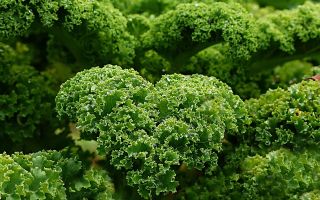Content
Curly Kale or Grunkol is an annual leafy vegetable that belongs to the Cabbage family and the Cabbage species. The benefits and harms of kale have been known for a long time. It was eaten by the ancient Greeks and Romans, calling it "sabelian keil". Until the end of the Middle Ages, this type of cabbage was the most widespread in Europe. The Japanese use kale as a drink. The Turks make soup, and in the Netherlands they add stamppot with potatoes and sausages to the traditional dish.
In Russia, kale was widespread until the end of the 18th century, due to its unpretentiousness and frost resistance. Today, Russians find it difficult to find "Russian red cabbage" on store shelves. All varieties of kale varieties are represented by the Italian variety.
Chemical composition of kale cabbage
Cale is a unique product. It combines the virtues of green leafy vegetables with the nutritional value of the finest meats. The beneficial properties of kale are due to its chemical composition. Half a cup of kale contains:
- a record amount of vitamin A (103% of the daily value);
- 60% of the daily value of vitamin C;
- 340% vitamin K, substances of group B1, 2, 3, 5, 6, 9, PP;
- 13% of the daily value of manganese;
- iron, and several times more than in beef and veal;
- it contains more calcium than the same amount of milk;
- potassium, zinc, phosphorus, selenium, sodium, copper;
- a lot of magnesium, which helps to fix calcium in tissues;
- omega-3 fatty acids;
- 4 g protein, ash;
- 18 amino acids, of which 9 are irreplaceable, not synthesized in the body;
- flavonoids, dietary fiber;
- glucosinolates with anti-cancer effects;
- lutein and zeakstantin.

Why is kail useful?
For several years, Harvard University researchers have been studying curly kale, revealing all the secrets of the vegetable, and what benefits it brings to the human body. It was this study that brought the new superfood to its peak. The benefits of Tuscan kale and other varieties of kale are invaluable:
- the antioxidants contained in it slow down the aging process;
- cheers up - there is an optimistic mood, good spirits;
- strengthens bone tissue, promotes their recovery in case of fractures;
- relieves inflammation and lowers cholesterol levels, preventing the formation of atherosclerotic plaques;
- reduces the risk of heart attack and stroke, strengthens the walls of blood vessels;
- helps to restore and improve vision, treats cataracts, glaucoma;
- removes toxic substances and toxins from the body;
- strengthens the immune system, restores the immune system, "killed" by improper use of antiviral and immunostimulating drugs;
- improves the condition of the skin, hair and nails, teeth;
- noticeably relieves pain during menstruation and the transition period with menopause;
- has a pronounced anti-cancer effect;
- helps to recover after exacerbation of gastrointestinal ulcers;
- is an effective prevention of colon cancer and osteoporosis;
- eliminates the cause of painful constipation;
- normalizes hormonal levels;
- helps to restore the functioning of the reproductive organs;
- is an easily digestible product suitable for medical and dietary nutrition:
- sulfarofan, present in the vegetable, helps with 140 different diseases;
- removes toxins at the cellular and genetic level, visibly healing the body.
Regular use of feces significantly improves the general condition of the human body, prevents early aging, raises tone and helps to lose excess weight, normalize metabolism. Feces are especially useful for people suffering from frequent colds, athletes and just fans of outdoor activities. For children, kale is a source of essential nutrients, the basis for a healthy diet and proper development. With increased eye strain, especially when working at a computer, it is recommended to use the kail daily.
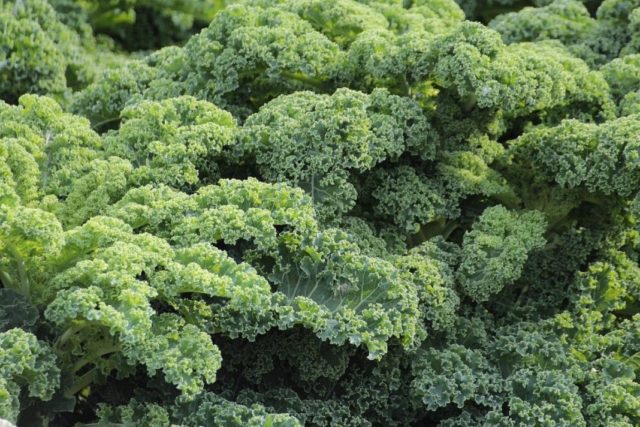
Kale cabbage harm
In general, this type of cabbage is absorbed surprisingly easily and without problems by the body, even weakened by a long illness. In very rare cases, there is an individual intolerance to the components present in the composition of the product. In addition, stale, moldy and sluggish kale leaves are dangerous.
Calorie content of cabbage kale
With increased nutritional value, a huge content of vital biologically active substances, minerals and vitamins, kale is a low-calorie product. 100 g of kale contains:
- proteins - 4.3 g;
- carbohydrates - 8.9 g;
- useful fiber - 3.6 g;
- vegetable fats - 0.9 g
The calorie content is only 48 kcal.
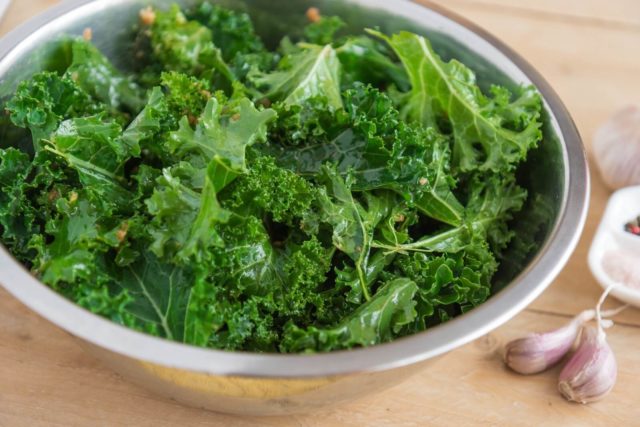
Contraindications to kale cabbage
Kale cabbage, excellent in its useful qualities, still has a number of contraindications that should be observed so as not to harm yourself. Use of the product should be limited or discontinued if:
- individual allergic reactions;
- kidney disease;
- increased blood clotting with a risk of thrombus formation;
- recent stroke or heart attack;
- hemorrhoids, varicose veins, thrombophlebitis;
- urolithiasis, since oxalic acid enhances the formation of stones.
Rules for the use of kale cabbage
When purchasing a diet superfood, you should choose juicy, bright leaves with an even color. It is advisable to carry the cabbage by dropping the cuttings into a container with a little water. Especially if it's hot summer outside.
The leaves must be sorted out, removing dubious specimens. Rinse in several waters, pouring into a wide bowl. Then it is advisable to soak for 15-25 minutes in well-salted cool water. Rinse again. Remove tough stems - only the soft parts of the leaves are good for food. Dry on a towel or napkin. Kale cabbage is ready to eat.
It is difficult to eat kale in pure form, because it has a very bitter taste.Therefore, it is used in various recipes, mixed with other vegetables:
- It goes well with lemon juice and fatty foods.
- In salads, they tear it by hand (in no case do they cut it with a knife).
- You can add pounded avocado, any vegetable oil that tastes soft, mashed potatoes.
- Kale can be used to cook first courses - cabbage soup, borscht, green soups.
- Legumes go well - chickpeas, beans, lentils.
- Healthy food advocates make kale chips using a dehydrator or oven, baking the leaves drizzled with oil and spices until crisp.
- A refreshing taste in kale salad with tomatoes or cucumbers.
If you didn't like an exotic, rather bitter vegetable from the first try, you can try to combine it with others that will change the rich taste. After all, the benefits of this unique leafy product are worth finding your own recipe that family members will like.
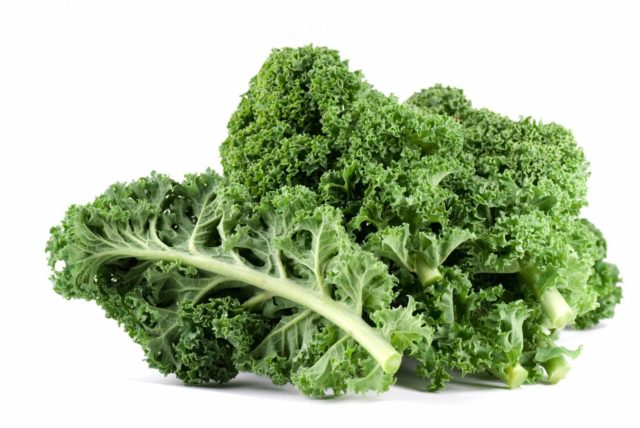
Cale during pregnancy
Women in position should use kale with caution if they have serious problems with blood vessels and gastrointestinal tract. For the rest, a vegetable in an amount of no more than 50 g per day will not bring harm, it will saturate the mother's body with the nutrients she and the child need.
Terms and conditions of storage
Fresh kale can be stored in the refrigerator for a week. Be sure to put the cuttings slices in clean cool water without additives.
For long-term storage, the kale can be frozen - it perfectly withstands this procedure without changing its special taste. The leaves should be pre-washed and dried. Place in even layers in bags or plastic covered containers and freeze. Shelf life is 2 months. The thawed product must not be frozen again.
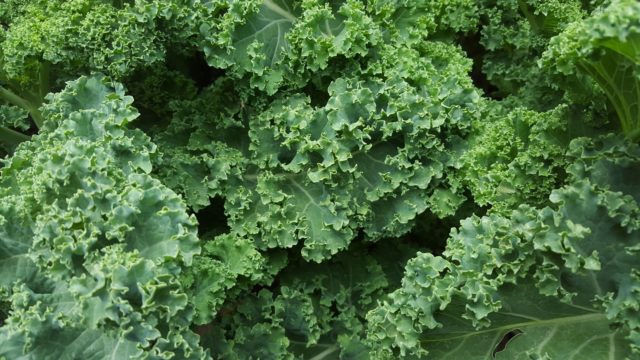
Conclusion
The benefits and harms of kale cabbage have been comprehensively studied and proven through many years of laboratory research. Enough 50 grams of leafy vegetables per day to feel great. Kale is especially useful for obesity, weakened immunity. It helps to recover from a protracted illness and is an effective means of preventing a number of dangerous diseases. You can use it both fresh, in salads, and boiled, baked. Fresh kale can be stored in the refrigerator for up to 7 days.

